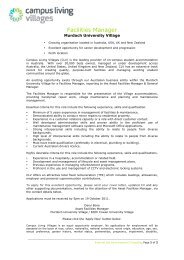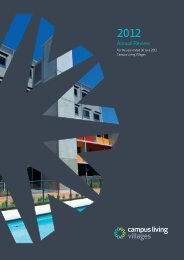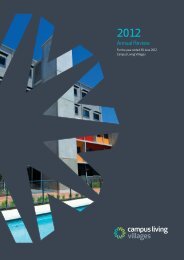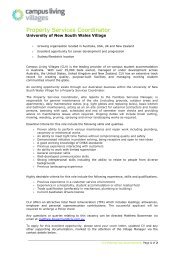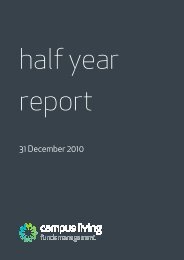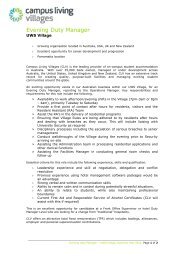Annual Report - Campus Living Villages
Annual Report - Campus Living Villages
Annual Report - Campus Living Villages
You also want an ePaper? Increase the reach of your titles
YUMPU automatically turns print PDFs into web optimized ePapers that Google loves.
5 8 <strong>Campus</strong> <strong>Living</strong> <strong>Villages</strong> <strong>Annual</strong> <strong>Report</strong> 09/10<br />
<strong>Campus</strong> <strong>Living</strong> Australia Trust<br />
NOTES TO THE CONSOLIDATED FINANCIAL STATEMENTS<br />
FOR THE YEAR ENDED 30 JUNE 2010<br />
A$’000<br />
CLAT<br />
1. Summary of accounting policies<br />
The principal accounting policies adopted in the preparation<br />
of the financial statements are set out below. These policies<br />
have been consistently applied for the entire year presented,<br />
unless otherwise stated. The financial statements include<br />
<strong>Campus</strong> <strong>Living</strong> Australia Trust (“CLAT”) and its subsidiaries<br />
(“consolidated entity”). CLAT is one of four trusts in a stapled<br />
group that form the <strong>Campus</strong> <strong>Living</strong> <strong>Villages</strong> Fund (“the Fund”),<br />
the units of which can only be purchased or sold in their<br />
current stapled arrangement.<br />
a) Basis of preparation<br />
This general purpose financial report has been prepared in<br />
accordance with Australian Accounting Standards, other<br />
authoritative pronouncements of the Australian Accounting<br />
Standards Board and the Corporations Act 2001.<br />
Compliance with IFRS<br />
The consolidated financial statements and notes of the<br />
Fund comply with International Financial <strong>Report</strong>ing<br />
Standards (IFRS) as issued by the International Accounting<br />
Standards Board.<br />
Historical cost convention<br />
These financial statements have been prepared under the<br />
historical cost convention except for financial assets and<br />
liabilities (including derivative instruments) which are carried<br />
at fair value through profit or loss.<br />
Critical accounting estimates<br />
The preparation of financial statements in conformity with<br />
Australian Accounting Standards requires the use of certain<br />
critical accounting estimates. It also requires management to<br />
exercise its judgement in the process of applying the entity’s<br />
accounting policies. The areas involving a higher degree of<br />
judgement or complexity, or areas where assumptions and<br />
estimates are significant to the financial statements, are set<br />
out in the applicable accounting policy note. Refer to Goodwill<br />
note 12 and Provisions note 15<br />
b) Principles of consolidation<br />
Subsidiaries are fully consolidated from the date on which<br />
control is transferred to the ‘consolidated entity’. They are<br />
de-consolidated from the date that control ceases.<br />
The acquisition method of accounting is used to account for<br />
the acquisition of subsidiaries by the consolidated entity as<br />
set out in “Business combinations” accounting policy note 1 (g).<br />
Intercompany transactions, balances and unrealised gains<br />
on transactions between consolidated entity companies are<br />
eliminated. Unrealised losses are also eliminated unless the<br />
transaction provides evidence of the impairment of the asset<br />
transferred. Accounting policies of subsidiaries have been<br />
changed where necessary to ensure consistency with the<br />
policies adopted by the consolidated entity.<br />
c) Foreign currency translation<br />
Functional and presentation currency<br />
Items included in the financial statements of each of the<br />
consolidated entity’s entities are measured using the currency<br />
of the primary economic environment in which the entity<br />
operates (‘the functional currency’). The consolidated financial<br />
statements are presented in Australian dollars, which is the<br />
consolidated entity’s functional and presentation currency.<br />
Transactions and balances<br />
Foreign currency transactions are translated into the<br />
functional currency using the exchange rates prevailing at<br />
the dates of the transactions. Foreign exchange gains and<br />
losses resulting from the settlement of such transactions and<br />
from the translation at year end exchange rates of monetary<br />
assets and liabilities denominated in foreign currencies are<br />
recognised in the income statement.<br />
Translation differences on non-monetary financial assets and<br />
liabilities are reported as part of the fair value gain or loss.<br />
Translation differences on non-monetary financial assets and<br />
liabilities such as equities held at fair value through profit or<br />
loss are recognised in profit or loss as part of the fair value<br />
gain or loss.<br />
Subsidiaries<br />
The consolidated financial statements incorporate the assets<br />
and liabilities of all subsidiaries of CLAT as at 30 June 2010<br />
and the results of all subsidiaries for the year then ended.<br />
CLAT and its subsidiaries together are referred to in this<br />
financial report as the consolidated entity.<br />
Subsidiaries are all those entities (including special purpose<br />
entities) over which the consolidated entity has the power<br />
to govern the financial and operating policies, generally<br />
accompanying a shareholding of more than one-half of the<br />
voting rights. The existence and effect of potential voting<br />
rights that are currently exercisable or convertible are<br />
considered when assessing whether the consolidated entity<br />
controls another entity.<br />
d) Revenue recognition<br />
Revenue is measured at the fair value of the consideration<br />
received or receivable. Amounts disclosed as revenue are net<br />
of discounts and refunds.<br />
The consolidated entity recognises revenue when the amount<br />
of revenue can be reliably measured, it is probable that future<br />
economic benefits will flow to the entity and specific criteria<br />
have been met for each of the consolidated entity’s activities<br />
as described below. The amount of revenue is not considered<br />
to be reliably measurable until all contingencies relating to the<br />
sale have been resolved.



